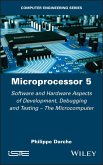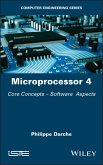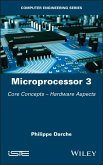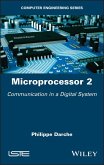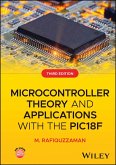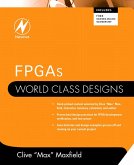Darshak S. Vasavada, S. K. Sinha
The Microprocessor (eBook, ePUB)
A Practical Introduction using the Arm Cortex-M0 Processor
83,99 €
83,99 €
inkl. MwSt.
Sofort per Download lieferbar

0 °P sammeln
83,99 €
Als Download kaufen

83,99 €
inkl. MwSt.
Sofort per Download lieferbar

0 °P sammeln
Jetzt verschenken
Alle Infos zum eBook verschenken
83,99 €
inkl. MwSt.
Sofort per Download lieferbar
Alle Infos zum eBook verschenken

0 °P sammeln
Darshak S. Vasavada, S. K. Sinha
The Microprocessor (eBook, ePUB)
A Practical Introduction using the Arm Cortex-M0 Processor
- Format: ePub
- Merkliste
- Auf die Merkliste
- Bewerten Bewerten
- Teilen
- Produkt teilen
- Produkterinnerung
- Produkterinnerung

Bitte loggen Sie sich zunächst in Ihr Kundenkonto ein oder registrieren Sie sich bei
bücher.de, um das eBook-Abo tolino select nutzen zu können.
Hier können Sie sich einloggen
Hier können Sie sich einloggen
Sie sind bereits eingeloggt. Klicken Sie auf 2. tolino select Abo, um fortzufahren.

Bitte loggen Sie sich zunächst in Ihr Kundenkonto ein oder registrieren Sie sich bei bücher.de, um das eBook-Abo tolino select nutzen zu können.
Provides a comprehensive introduction to microprocessor architecture and programming concepts, using the Arm ® Cortex ® -M0 processor as an example
The Microprocessor offers a supremely accessible and user-friendly introduction to microprocessor basics: instruction set, the exception model, system architecture and microcontroller programming. Explaining the working principles with simplified models, this first-level book builds the base for all onward courses at intermediate and advanced levels.
Filled with exercises that can be executed on the free version of Keil ® µVision ® MDK…mehr
- Geräte: eReader
- mit Kopierschutz
- eBook Hilfe
- Größe: 14.94MB
Andere Kunden interessierten sich auch für
![Microprocessor 5 (eBook, ePUB) Microprocessor 5 (eBook, ePUB)]() Philippe DarcheMicroprocessor 5 (eBook, ePUB)139,99 €
Philippe DarcheMicroprocessor 5 (eBook, ePUB)139,99 €![Microprocessor 4 (eBook, ePUB) Microprocessor 4 (eBook, ePUB)]() Philippe DarcheMicroprocessor 4 (eBook, ePUB)139,99 €
Philippe DarcheMicroprocessor 4 (eBook, ePUB)139,99 €![Microprocessor 3 (eBook, ePUB) Microprocessor 3 (eBook, ePUB)]() Philippe DarcheMicroprocessor 3 (eBook, ePUB)139,99 €
Philippe DarcheMicroprocessor 3 (eBook, ePUB)139,99 €![Microprocessor 2 (eBook, ePUB) Microprocessor 2 (eBook, ePUB)]() Philippe DarcheMicroprocessor 2 (eBook, ePUB)139,99 €
Philippe DarcheMicroprocessor 2 (eBook, ePUB)139,99 €![Techniques for Surviving the Mobile Data Explosion (eBook, ePUB) Techniques for Surviving the Mobile Data Explosion (eBook, ePUB)]() Dinesh VermaTechniques for Surviving the Mobile Data Explosion (eBook, ePUB)75,99 €
Dinesh VermaTechniques for Surviving the Mobile Data Explosion (eBook, ePUB)75,99 €![Microcontroller Theory and Applications with the PIC18F (eBook, ePUB) Microcontroller Theory and Applications with the PIC18F (eBook, ePUB)]() M. RafiquzzamanMicrocontroller Theory and Applications with the PIC18F (eBook, ePUB)108,99 €
M. RafiquzzamanMicrocontroller Theory and Applications with the PIC18F (eBook, ePUB)108,99 €![FPGAs: World Class Designs (eBook, ePUB) FPGAs: World Class Designs (eBook, ePUB)]() FPGAs: World Class Designs (eBook, ePUB)31,95 €
FPGAs: World Class Designs (eBook, ePUB)31,95 €-
-
-
Provides a comprehensive introduction to microprocessor architecture and programming concepts, using the Arm® Cortex®-M0 processor as an example
The Microprocessor offers a supremely accessible and user-friendly introduction to microprocessor basics: instruction set, the exception model, system architecture and microcontroller programming. Explaining the working principles with simplified models, this first-level book builds the base for all onward courses at intermediate and advanced levels.
Filled with exercises that can be executed on the free version of Keil® µVision® MDK without any hardware, the book explains the essential aspects of microprocessor architecture with simple programming examples in assembly and C. By blending conceptual knowledge with practical exercises, the book offers valuable insights that equip readers to engage with real-world applications in the fields of microprocessor architecture and embedded systems.
The Microprocessor offers a supremely accessible and user-friendly introduction to microprocessor basics: instruction set, the exception model, system architecture and microcontroller programming. Explaining the working principles with simplified models, this first-level book builds the base for all onward courses at intermediate and advanced levels.
Filled with exercises that can be executed on the free version of Keil® µVision® MDK without any hardware, the book explains the essential aspects of microprocessor architecture with simple programming examples in assembly and C. By blending conceptual knowledge with practical exercises, the book offers valuable insights that equip readers to engage with real-world applications in the fields of microprocessor architecture and embedded systems.
Dieser Download kann aus rechtlichen Gründen nur mit Rechnungsadresse in D ausgeliefert werden.
Produktdetails
- Produktdetails
- Verlag: John Wiley & Sons
- Seitenzahl: 864
- Erscheinungstermin: 3. Juni 2025
- Englisch
- ISBN-13: 9781394245307
- Artikelnr.: 74354305
- Verlag: John Wiley & Sons
- Seitenzahl: 864
- Erscheinungstermin: 3. Juni 2025
- Englisch
- ISBN-13: 9781394245307
- Artikelnr.: 74354305
- Herstellerkennzeichnung Die Herstellerinformationen sind derzeit nicht verfügbar.
Darshak S. Vasavada has extensive corporate as well as teaching experience in embedded DSP and multimedia systems. At present, he teaches real-time embedded system design at Robert Bosch Center for Cyber-Physical Systems at Indian Institute of Science, Bangalore.
S. K. Sinha, retired from Department of Electronic Systems Engineering (DESE, earlier known as CEDT), Indian Institute of Science, Bangalore, set up the first embedded systems lab at CEDT and has helped introduce MTech courses in several colleges in India. At present, he is Chief Architect at Lab To Market Innovations, specializing in reliable IIoT systems.
The authors have contributed to several workshops on embedded systems for teachers and students in various colleges, which have been the source of motivation behind this book.
S. K. Sinha, retired from Department of Electronic Systems Engineering (DESE, earlier known as CEDT), Indian Institute of Science, Bangalore, set up the first embedded systems lab at CEDT and has helped introduce MTech courses in several colleges in India. At present, he is Chief Architect at Lab To Market Innovations, specializing in reliable IIoT systems.
The authors have contributed to several workshops on embedded systems for teachers and students in various colleges, which have been the source of motivation behind this book.
List of Exercises x
Preface xiii
About This Book xv
How to Read This Book xvi
Acknowledgements xviii
About the Companion Website xix
Introduction xxi
Chapter 1 Microprocessor System 1
1.1 Introduction 2
1.2 Processor 3
1.3 Memory 5
1.4 Memory Devices 7
1.5 Bus 10
1.6 IO Ports 14
1.7 Reset, Clock and Power Management 16
1.8 Overview of Arm Cortex-M0 Processor 17
1.9 Summary 20
Chapter 2 Instruction Set Architecture 25
2.1 Introduction 25
2.2 Registers 27
2.3 Instruction Set 28
2.4 Structure of an Instruction 30
2.5 Data-Processing Instructions 33
2.6 Memory-Access Instructions 37
2.7 Program-Control Instructions 43
2.8 Summary 47
Chapter 3 Program Execution 49
3.1 Introduction 49
3.2 Program 50
3.3 Inside the CPU 52
3.4 Fetch Unit 55
3.5 Decode Unit 57
3.6 Execution Unit 59
3.7 Instruction Execution 63
3.8 Processor Pipeline 66
3.9 Summary 68
Chapter 4 Assembly Programming 71
4.1 Statements 72
4.2 Labels 73
4.3 Sections 75
4.4 Text Section 77
4.5 Data Sections 84
4.6 Summary 90
Chapter 5 Arithmetic Operations 93
5.1 Arithmetic Instructions 94
5.2 Unsigned Integers 96
5.3 Signed Integers 99
5.4 APSR Flags 101
5.5 Condition Codes 106
5.6 Summary 110
Chapter 6 Bit-Level Operations 113
6.1 Boolean Instructions 114
6.2 Bit Manipulation 116
6.3 Shift Operations 119
6.4 Word-Length Extension 125
6.5 Byte Ordering Instructions 127
6.6 Summary 129
Chapter 7 Load and Store Operations 131
7.1 Introduction 131
7.2 Alignment 133
7.3 Endianness 135
7.4 Basic Load and Store Operations 140
7.5 Data Types 142
7.6 Offset Addressing 145
7.7 Summary 153
Chapter 8 Branch and Subroutine 155
8.1 Program-Control Instructions 155
8.2 Branch 156
8.3 Conditional Branch 158
8.4 Indirect Branch 162
8.5 Subroutines 166
8.6 Nested Subroutines 169
8.7 Summary 173
Chapter 9 Stack Operations 175
9.1 Introduction 175
9.2 What Is a Stack? 177
9.3 Stack in Cortex-M 0 178
9.4 Stack Operations 180
9.5 Creating a Stack 182
9.6 Using the Stack 185
9.7 Local Variables 190
9.8 Summary 193
Chapter 10 Exceptions 195
10.1 Introduction 196
10.2 Exception Model 198
10.3 Vector Table 200
10.4 Reset 206
10.5 Faults 209
10.6 Exception Stack Frame 211
10.7 Summary 215
Chapter 11 SysTick and Core Interrupts 217
11.1 Introduction 218
11.2 SysTick 218
11.3 SysTick Programming Model 219
11.4 Programming SysTick 222
11.5 Using SysTick 224
11.6 Polling with SysTick 226
11.7 SysTick Interrupts 228
11.8 Interrupt Masking 232
11.9 Non-maskable Interrupt (NMI) 235
11.10 Summary 237
Chapter 12 Introduction to C Programming 239
12.1 Programming Languages 240
12.2 Structure of a C Program 241
12.3 Functions 244
12.4 Data 247
12.5 Header Files 250
12.6 Overview of C Language 257
12.7 Summary 259
Chapter 13 Basic Data Types 263
13.1 Characters and Strings 263
13.2 Integers 268
13.3 Floating-Point Numbers 277
13.4 Floating-Point Operations 280
13.5 Type-Casting 284
13.6 Summary 285
Chapter 14 Functions 289
14.1 Function Calls 290
14.2 Arguments 292
14.3 Local Variables 295
14.4 Conditional Execution 297
14.5 Selection 301
14.6 Loops 305
14.7 Summary 312
Chapter 15 Extended Data Types 315
15.1 Arrays 315
15.2 Structures 319
15.3 Pointers 323
15.4 Arrays and Pointers 327
15.5 Pointer to a Structure 330
15.6 Pointer Arithmetic 332
15.7 Uninitialized Pointers 334
15.8 Summary 339
Chapter 16 Compilation Process 341
16.1 Overview of the Compilation Process 342
16.2 Preprocessing 345
16.3 Compilation 348
16.4 Assembler 354
16.5 Linker 357
16.6 Executable Program 361
16.7 Summary 364
Chapter 17 Microcontroller 367
17.1 Introduction 368
17.2 Block Diagram 369
17.3 Pin Diagram 372
17.4 Reset, Clock and Power Management 373
17.5 Peripheral Interrupts 379
17.6 Peripheral Registers 382
17.7 Peripheral API 387
17.8 Summary 389
Chapter 18 IO Programming 393
18.1 IO Devices 394
18.2 GPIO 396
18.3 Timer 400
18.4 ADC 403
18.5 DAC 407
18.6 UART 410
18.7 Interrupts 414
18.8 Summary 419
Chapter 19 Microprocessor Applications 423
19.1 LED Brightness Controller 424
19.2 Ambient Light Sensor 427
19.3 Energy-Efficient Coding 430
19.4 Temperature Monitoring 433
19.5 Motor Speed Control 435
19.6 Summary 441
Appendix A Programming Environment 443
A.1 Introduction 444
A.2 Keil MDK 446
A.3 Assembly Programming Setup 449
A.4 Writing and Building Assembly Programs 452
A.5 Debugging an Assembly Program 454
A.6 c Programming Setup 458
A.7 Writing and Building C Program 460
A.8 Debugging A C Program 461
A.9 Debugger 464
Appendix B Advanced Topics 467
B.1 System-Control Instructions 467
B.2 OS Support 470
Appendix C Startup Code 475
C.1 OS-Less System 475
C.2 Startup Code 478
C.3 Linker Script File 481
Appendix D AM0 Header Files 483
D.1 Register Header File 483
D.2 AM0 Header File 484
Glossary of Acronyms 487
References 491
Index 493
Preface xiii
About This Book xv
How to Read This Book xvi
Acknowledgements xviii
About the Companion Website xix
Introduction xxi
Chapter 1 Microprocessor System 1
1.1 Introduction 2
1.2 Processor 3
1.3 Memory 5
1.4 Memory Devices 7
1.5 Bus 10
1.6 IO Ports 14
1.7 Reset, Clock and Power Management 16
1.8 Overview of Arm Cortex-M0 Processor 17
1.9 Summary 20
Chapter 2 Instruction Set Architecture 25
2.1 Introduction 25
2.2 Registers 27
2.3 Instruction Set 28
2.4 Structure of an Instruction 30
2.5 Data-Processing Instructions 33
2.6 Memory-Access Instructions 37
2.7 Program-Control Instructions 43
2.8 Summary 47
Chapter 3 Program Execution 49
3.1 Introduction 49
3.2 Program 50
3.3 Inside the CPU 52
3.4 Fetch Unit 55
3.5 Decode Unit 57
3.6 Execution Unit 59
3.7 Instruction Execution 63
3.8 Processor Pipeline 66
3.9 Summary 68
Chapter 4 Assembly Programming 71
4.1 Statements 72
4.2 Labels 73
4.3 Sections 75
4.4 Text Section 77
4.5 Data Sections 84
4.6 Summary 90
Chapter 5 Arithmetic Operations 93
5.1 Arithmetic Instructions 94
5.2 Unsigned Integers 96
5.3 Signed Integers 99
5.4 APSR Flags 101
5.5 Condition Codes 106
5.6 Summary 110
Chapter 6 Bit-Level Operations 113
6.1 Boolean Instructions 114
6.2 Bit Manipulation 116
6.3 Shift Operations 119
6.4 Word-Length Extension 125
6.5 Byte Ordering Instructions 127
6.6 Summary 129
Chapter 7 Load and Store Operations 131
7.1 Introduction 131
7.2 Alignment 133
7.3 Endianness 135
7.4 Basic Load and Store Operations 140
7.5 Data Types 142
7.6 Offset Addressing 145
7.7 Summary 153
Chapter 8 Branch and Subroutine 155
8.1 Program-Control Instructions 155
8.2 Branch 156
8.3 Conditional Branch 158
8.4 Indirect Branch 162
8.5 Subroutines 166
8.6 Nested Subroutines 169
8.7 Summary 173
Chapter 9 Stack Operations 175
9.1 Introduction 175
9.2 What Is a Stack? 177
9.3 Stack in Cortex-M 0 178
9.4 Stack Operations 180
9.5 Creating a Stack 182
9.6 Using the Stack 185
9.7 Local Variables 190
9.8 Summary 193
Chapter 10 Exceptions 195
10.1 Introduction 196
10.2 Exception Model 198
10.3 Vector Table 200
10.4 Reset 206
10.5 Faults 209
10.6 Exception Stack Frame 211
10.7 Summary 215
Chapter 11 SysTick and Core Interrupts 217
11.1 Introduction 218
11.2 SysTick 218
11.3 SysTick Programming Model 219
11.4 Programming SysTick 222
11.5 Using SysTick 224
11.6 Polling with SysTick 226
11.7 SysTick Interrupts 228
11.8 Interrupt Masking 232
11.9 Non-maskable Interrupt (NMI) 235
11.10 Summary 237
Chapter 12 Introduction to C Programming 239
12.1 Programming Languages 240
12.2 Structure of a C Program 241
12.3 Functions 244
12.4 Data 247
12.5 Header Files 250
12.6 Overview of C Language 257
12.7 Summary 259
Chapter 13 Basic Data Types 263
13.1 Characters and Strings 263
13.2 Integers 268
13.3 Floating-Point Numbers 277
13.4 Floating-Point Operations 280
13.5 Type-Casting 284
13.6 Summary 285
Chapter 14 Functions 289
14.1 Function Calls 290
14.2 Arguments 292
14.3 Local Variables 295
14.4 Conditional Execution 297
14.5 Selection 301
14.6 Loops 305
14.7 Summary 312
Chapter 15 Extended Data Types 315
15.1 Arrays 315
15.2 Structures 319
15.3 Pointers 323
15.4 Arrays and Pointers 327
15.5 Pointer to a Structure 330
15.6 Pointer Arithmetic 332
15.7 Uninitialized Pointers 334
15.8 Summary 339
Chapter 16 Compilation Process 341
16.1 Overview of the Compilation Process 342
16.2 Preprocessing 345
16.3 Compilation 348
16.4 Assembler 354
16.5 Linker 357
16.6 Executable Program 361
16.7 Summary 364
Chapter 17 Microcontroller 367
17.1 Introduction 368
17.2 Block Diagram 369
17.3 Pin Diagram 372
17.4 Reset, Clock and Power Management 373
17.5 Peripheral Interrupts 379
17.6 Peripheral Registers 382
17.7 Peripheral API 387
17.8 Summary 389
Chapter 18 IO Programming 393
18.1 IO Devices 394
18.2 GPIO 396
18.3 Timer 400
18.4 ADC 403
18.5 DAC 407
18.6 UART 410
18.7 Interrupts 414
18.8 Summary 419
Chapter 19 Microprocessor Applications 423
19.1 LED Brightness Controller 424
19.2 Ambient Light Sensor 427
19.3 Energy-Efficient Coding 430
19.4 Temperature Monitoring 433
19.5 Motor Speed Control 435
19.6 Summary 441
Appendix A Programming Environment 443
A.1 Introduction 444
A.2 Keil MDK 446
A.3 Assembly Programming Setup 449
A.4 Writing and Building Assembly Programs 452
A.5 Debugging an Assembly Program 454
A.6 c Programming Setup 458
A.7 Writing and Building C Program 460
A.8 Debugging A C Program 461
A.9 Debugger 464
Appendix B Advanced Topics 467
B.1 System-Control Instructions 467
B.2 OS Support 470
Appendix C Startup Code 475
C.1 OS-Less System 475
C.2 Startup Code 478
C.3 Linker Script File 481
Appendix D AM0 Header Files 483
D.1 Register Header File 483
D.2 AM0 Header File 484
Glossary of Acronyms 487
References 491
Index 493
List of Exercises x
Preface xiii
About This Book xv
How to Read This Book xvi
Acknowledgements xviii
About the Companion Website xix
Introduction xxi
Chapter 1 Microprocessor System 1
1.1 Introduction 2
1.2 Processor 3
1.3 Memory 5
1.4 Memory Devices 7
1.5 Bus 10
1.6 IO Ports 14
1.7 Reset, Clock and Power Management 16
1.8 Overview of Arm Cortex-M0 Processor 17
1.9 Summary 20
Chapter 2 Instruction Set Architecture 25
2.1 Introduction 25
2.2 Registers 27
2.3 Instruction Set 28
2.4 Structure of an Instruction 30
2.5 Data-Processing Instructions 33
2.6 Memory-Access Instructions 37
2.7 Program-Control Instructions 43
2.8 Summary 47
Chapter 3 Program Execution 49
3.1 Introduction 49
3.2 Program 50
3.3 Inside the CPU 52
3.4 Fetch Unit 55
3.5 Decode Unit 57
3.6 Execution Unit 59
3.7 Instruction Execution 63
3.8 Processor Pipeline 66
3.9 Summary 68
Chapter 4 Assembly Programming 71
4.1 Statements 72
4.2 Labels 73
4.3 Sections 75
4.4 Text Section 77
4.5 Data Sections 84
4.6 Summary 90
Chapter 5 Arithmetic Operations 93
5.1 Arithmetic Instructions 94
5.2 Unsigned Integers 96
5.3 Signed Integers 99
5.4 APSR Flags 101
5.5 Condition Codes 106
5.6 Summary 110
Chapter 6 Bit-Level Operations 113
6.1 Boolean Instructions 114
6.2 Bit Manipulation 116
6.3 Shift Operations 119
6.4 Word-Length Extension 125
6.5 Byte Ordering Instructions 127
6.6 Summary 129
Chapter 7 Load and Store Operations 131
7.1 Introduction 131
7.2 Alignment 133
7.3 Endianness 135
7.4 Basic Load and Store Operations 140
7.5 Data Types 142
7.6 Offset Addressing 145
7.7 Summary 153
Chapter 8 Branch and Subroutine 155
8.1 Program-Control Instructions 155
8.2 Branch 156
8.3 Conditional Branch 158
8.4 Indirect Branch 162
8.5 Subroutines 166
8.6 Nested Subroutines 169
8.7 Summary 173
Chapter 9 Stack Operations 175
9.1 Introduction 175
9.2 What Is a Stack? 177
9.3 Stack in Cortex-M 0 178
9.4 Stack Operations 180
9.5 Creating a Stack 182
9.6 Using the Stack 185
9.7 Local Variables 190
9.8 Summary 193
Chapter 10 Exceptions 195
10.1 Introduction 196
10.2 Exception Model 198
10.3 Vector Table 200
10.4 Reset 206
10.5 Faults 209
10.6 Exception Stack Frame 211
10.7 Summary 215
Chapter 11 SysTick and Core Interrupts 217
11.1 Introduction 218
11.2 SysTick 218
11.3 SysTick Programming Model 219
11.4 Programming SysTick 222
11.5 Using SysTick 224
11.6 Polling with SysTick 226
11.7 SysTick Interrupts 228
11.8 Interrupt Masking 232
11.9 Non-maskable Interrupt (NMI) 235
11.10 Summary 237
Chapter 12 Introduction to C Programming 239
12.1 Programming Languages 240
12.2 Structure of a C Program 241
12.3 Functions 244
12.4 Data 247
12.5 Header Files 250
12.6 Overview of C Language 257
12.7 Summary 259
Chapter 13 Basic Data Types 263
13.1 Characters and Strings 263
13.2 Integers 268
13.3 Floating-Point Numbers 277
13.4 Floating-Point Operations 280
13.5 Type-Casting 284
13.6 Summary 285
Chapter 14 Functions 289
14.1 Function Calls 290
14.2 Arguments 292
14.3 Local Variables 295
14.4 Conditional Execution 297
14.5 Selection 301
14.6 Loops 305
14.7 Summary 312
Chapter 15 Extended Data Types 315
15.1 Arrays 315
15.2 Structures 319
15.3 Pointers 323
15.4 Arrays and Pointers 327
15.5 Pointer to a Structure 330
15.6 Pointer Arithmetic 332
15.7 Uninitialized Pointers 334
15.8 Summary 339
Chapter 16 Compilation Process 341
16.1 Overview of the Compilation Process 342
16.2 Preprocessing 345
16.3 Compilation 348
16.4 Assembler 354
16.5 Linker 357
16.6 Executable Program 361
16.7 Summary 364
Chapter 17 Microcontroller 367
17.1 Introduction 368
17.2 Block Diagram 369
17.3 Pin Diagram 372
17.4 Reset, Clock and Power Management 373
17.5 Peripheral Interrupts 379
17.6 Peripheral Registers 382
17.7 Peripheral API 387
17.8 Summary 389
Chapter 18 IO Programming 393
18.1 IO Devices 394
18.2 GPIO 396
18.3 Timer 400
18.4 ADC 403
18.5 DAC 407
18.6 UART 410
18.7 Interrupts 414
18.8 Summary 419
Chapter 19 Microprocessor Applications 423
19.1 LED Brightness Controller 424
19.2 Ambient Light Sensor 427
19.3 Energy-Efficient Coding 430
19.4 Temperature Monitoring 433
19.5 Motor Speed Control 435
19.6 Summary 441
Appendix A Programming Environment 443
A.1 Introduction 444
A.2 Keil MDK 446
A.3 Assembly Programming Setup 449
A.4 Writing and Building Assembly Programs 452
A.5 Debugging an Assembly Program 454
A.6 c Programming Setup 458
A.7 Writing and Building C Program 460
A.8 Debugging A C Program 461
A.9 Debugger 464
Appendix B Advanced Topics 467
B.1 System-Control Instructions 467
B.2 OS Support 470
Appendix C Startup Code 475
C.1 OS-Less System 475
C.2 Startup Code 478
C.3 Linker Script File 481
Appendix D AM0 Header Files 483
D.1 Register Header File 483
D.2 AM0 Header File 484
Glossary of Acronyms 487
References 491
Index 493
Preface xiii
About This Book xv
How to Read This Book xvi
Acknowledgements xviii
About the Companion Website xix
Introduction xxi
Chapter 1 Microprocessor System 1
1.1 Introduction 2
1.2 Processor 3
1.3 Memory 5
1.4 Memory Devices 7
1.5 Bus 10
1.6 IO Ports 14
1.7 Reset, Clock and Power Management 16
1.8 Overview of Arm Cortex-M0 Processor 17
1.9 Summary 20
Chapter 2 Instruction Set Architecture 25
2.1 Introduction 25
2.2 Registers 27
2.3 Instruction Set 28
2.4 Structure of an Instruction 30
2.5 Data-Processing Instructions 33
2.6 Memory-Access Instructions 37
2.7 Program-Control Instructions 43
2.8 Summary 47
Chapter 3 Program Execution 49
3.1 Introduction 49
3.2 Program 50
3.3 Inside the CPU 52
3.4 Fetch Unit 55
3.5 Decode Unit 57
3.6 Execution Unit 59
3.7 Instruction Execution 63
3.8 Processor Pipeline 66
3.9 Summary 68
Chapter 4 Assembly Programming 71
4.1 Statements 72
4.2 Labels 73
4.3 Sections 75
4.4 Text Section 77
4.5 Data Sections 84
4.6 Summary 90
Chapter 5 Arithmetic Operations 93
5.1 Arithmetic Instructions 94
5.2 Unsigned Integers 96
5.3 Signed Integers 99
5.4 APSR Flags 101
5.5 Condition Codes 106
5.6 Summary 110
Chapter 6 Bit-Level Operations 113
6.1 Boolean Instructions 114
6.2 Bit Manipulation 116
6.3 Shift Operations 119
6.4 Word-Length Extension 125
6.5 Byte Ordering Instructions 127
6.6 Summary 129
Chapter 7 Load and Store Operations 131
7.1 Introduction 131
7.2 Alignment 133
7.3 Endianness 135
7.4 Basic Load and Store Operations 140
7.5 Data Types 142
7.6 Offset Addressing 145
7.7 Summary 153
Chapter 8 Branch and Subroutine 155
8.1 Program-Control Instructions 155
8.2 Branch 156
8.3 Conditional Branch 158
8.4 Indirect Branch 162
8.5 Subroutines 166
8.6 Nested Subroutines 169
8.7 Summary 173
Chapter 9 Stack Operations 175
9.1 Introduction 175
9.2 What Is a Stack? 177
9.3 Stack in Cortex-M 0 178
9.4 Stack Operations 180
9.5 Creating a Stack 182
9.6 Using the Stack 185
9.7 Local Variables 190
9.8 Summary 193
Chapter 10 Exceptions 195
10.1 Introduction 196
10.2 Exception Model 198
10.3 Vector Table 200
10.4 Reset 206
10.5 Faults 209
10.6 Exception Stack Frame 211
10.7 Summary 215
Chapter 11 SysTick and Core Interrupts 217
11.1 Introduction 218
11.2 SysTick 218
11.3 SysTick Programming Model 219
11.4 Programming SysTick 222
11.5 Using SysTick 224
11.6 Polling with SysTick 226
11.7 SysTick Interrupts 228
11.8 Interrupt Masking 232
11.9 Non-maskable Interrupt (NMI) 235
11.10 Summary 237
Chapter 12 Introduction to C Programming 239
12.1 Programming Languages 240
12.2 Structure of a C Program 241
12.3 Functions 244
12.4 Data 247
12.5 Header Files 250
12.6 Overview of C Language 257
12.7 Summary 259
Chapter 13 Basic Data Types 263
13.1 Characters and Strings 263
13.2 Integers 268
13.3 Floating-Point Numbers 277
13.4 Floating-Point Operations 280
13.5 Type-Casting 284
13.6 Summary 285
Chapter 14 Functions 289
14.1 Function Calls 290
14.2 Arguments 292
14.3 Local Variables 295
14.4 Conditional Execution 297
14.5 Selection 301
14.6 Loops 305
14.7 Summary 312
Chapter 15 Extended Data Types 315
15.1 Arrays 315
15.2 Structures 319
15.3 Pointers 323
15.4 Arrays and Pointers 327
15.5 Pointer to a Structure 330
15.6 Pointer Arithmetic 332
15.7 Uninitialized Pointers 334
15.8 Summary 339
Chapter 16 Compilation Process 341
16.1 Overview of the Compilation Process 342
16.2 Preprocessing 345
16.3 Compilation 348
16.4 Assembler 354
16.5 Linker 357
16.6 Executable Program 361
16.7 Summary 364
Chapter 17 Microcontroller 367
17.1 Introduction 368
17.2 Block Diagram 369
17.3 Pin Diagram 372
17.4 Reset, Clock and Power Management 373
17.5 Peripheral Interrupts 379
17.6 Peripheral Registers 382
17.7 Peripheral API 387
17.8 Summary 389
Chapter 18 IO Programming 393
18.1 IO Devices 394
18.2 GPIO 396
18.3 Timer 400
18.4 ADC 403
18.5 DAC 407
18.6 UART 410
18.7 Interrupts 414
18.8 Summary 419
Chapter 19 Microprocessor Applications 423
19.1 LED Brightness Controller 424
19.2 Ambient Light Sensor 427
19.3 Energy-Efficient Coding 430
19.4 Temperature Monitoring 433
19.5 Motor Speed Control 435
19.6 Summary 441
Appendix A Programming Environment 443
A.1 Introduction 444
A.2 Keil MDK 446
A.3 Assembly Programming Setup 449
A.4 Writing and Building Assembly Programs 452
A.5 Debugging an Assembly Program 454
A.6 c Programming Setup 458
A.7 Writing and Building C Program 460
A.8 Debugging A C Program 461
A.9 Debugger 464
Appendix B Advanced Topics 467
B.1 System-Control Instructions 467
B.2 OS Support 470
Appendix C Startup Code 475
C.1 OS-Less System 475
C.2 Startup Code 478
C.3 Linker Script File 481
Appendix D AM0 Header Files 483
D.1 Register Header File 483
D.2 AM0 Header File 484
Glossary of Acronyms 487
References 491
Index 493

